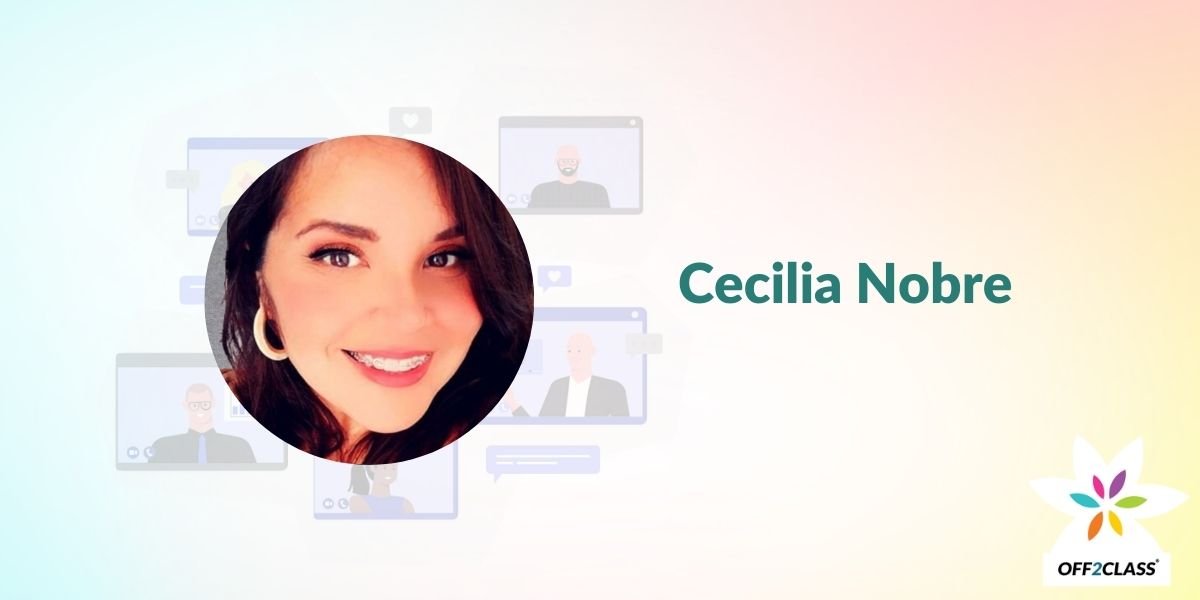8 min read
Share this post

Cecilia Nobre is an ELT (English Language Teaching) Teacher and a Teacher Trainer based in Turkey. She has a website that you can find lots of useful information on teaching, visit it here. Also check out Cecilia’s Twitter, LinkedIn and Instagram. Keep scrolling to read more about how to structure an ESL lesson effectively.
For many ESL teachers, it can be difficult to know how to structure lessons effectively and promptly. Without guidance, this can be difficult to master. Here at Off2Class, we are committed to offering teachers the most practical information to help improve their teaching skills. Sometimes this means we reach out to other ESL experts for help. Recently, we had the pleasure of hosting Cecilia Nobre in our Facebook Group and she shared nine tips to determine how to structure an ESL lesson. After this, we realized how important this discussion is so we decided to create a blog post outlining Cecilia’s incredible teaching tips. By the time you are finished reading this blog post, you will not only know how to structure an ESL lesson but ways to improve your current teaching practices.
You can watch Cecilia’s video on how to structure an ESL lesson below:
To structure your ESL lesson effectively, it’s important to keep in mind what learning outcomes you want your students to achieve. So you should start planning the lesson with these in mind! Many teachers find it easier to do this by starting to plan the end of the lesson and working backwards to the start. This allows you to have a clear idea of what you need to cover to stage your lesson outcomes accordingly. As well, you will have a clear trajectory to guide you when you are choosing relevant resources and materials. Of course, if you feel it is more suitable to start planning from the beginning point of the lesson, then do what works best for you!
Though this tip might seem overwhelming at first, it is going to help you if you use it. When you plan a series of lessons you are maximizing your planning time. Essentially, plan a series of two to three lessons that are related and relevant to the topic(s) you are covering but focus on different aspects of skill development. For example, lesson one could focus on speaking and listening. Then the following lesson could be used to help develop reading skills. The third lesson could be heavy in writing activities. This allows you to cover topics in depth while helping your students develop a full range of skills relevant to English language learning. As well, this will guide you in choosing appropriate activities and resources for each lesson.
You’re probably thinking, wait, am I still reading an article on how to structure an ESL lesson plan? You most definitely are. This is a tip that you can use during a lesson to help you plan future lessons. Before we delve further into this tip, what is incidental language? Incidental language refers to unplanned, natural interactions that take place between a teacher and student; it is not usually structured into a lesson.
Throughout the lesson, you should take note of any incidental language that arises. Whether this means writing it on paper/ in a notepad or typing it in a separate document, utilize what process works for you. These notes will provide you with a wealth of information to help you plan future lessons that address the direct needs of your students. As well, this will help you further assess your student’s understanding of the English language.
As an ESL teacher, it’s crucial to have a variety of resources at your disposal at all times in the classroom. In addition to the materials you have planned to use in the lesson, you should have extra material to complement them. Extra materials include flashcards, worksheets, games and conversation prompts. These are often available in digital formats and can be saved in a file on your computer or wherever you find convenient. When you incorporate these into the lesson, it will be fun, educational and dynamic for you and your student(s).
This is a tip that will save you a lot of time in the long run, especially as you start to gain more students. Just as you should take note of incidental language, you should take note of what lessons are good for what groups. For example, if you find that a particular lesson has a variety of speaking prompts for beginners, you can use it as a staple with these learning groups. As you start to teach more students and utilize more materials, you will learn what lessons are suitable for what students. This will allow you to maximize your time, especially if you keep the lessons labelled and organized.
When planning an ESL lesson, a review is always a great place to start. You can allocate a couple of minutes at the beginning of the lesson to review concepts from the past one to two lessons (remember repetition means retention). As well, this review time can be structured based on notes you might have taken throughout the past lesson(s). Either way, use this as a point to reinforce past concepts and assess student retention.
When structuring lessons, teachers often get overwhelmed with the vast amount of resources available to them. Though often these resources are not organized in such a way that supports a student’s individual learning needs. So as a teacher it’s important to determine what you want your students to learn before selecting materials. Once you have determined your lesson objective you will easily be able to find suitable materials. This will prevent you from going down a time-consuming and confusing rabbit hole of online ESL materials. In any case, don’t be too attached to any materials and choose them based on what your student needs. If you are looking for organized and useful resources, Off2Class is a great place to start. There are assessment tools, curriculum and additional tools that help individualize the learning experience of your students.
There are so many tools available for teachers to utilize, especially in online ESL classrooms. From Zoom to Nearpod, there are so many digital tools teachers can use to improve classes. However, the trick is using tech tools that work for you. Do not waste time learning how to use new software if you do not need to. If you continuously try to incorporate new tools, this will be overwhelming for both you and your students. Cecilia recommends using no more than two tools in class. For example, you could use Zoom and a whiteboard; she says that’s a great combination. In any case, she emphasizes that it is important to focus on your craft as tools are there to help you deliver the lesson, “they are not the stars of the show!”.
Finally, Cecilia recommends that to structure your lesson effectively you should include a reflection lesson at the end of it. To do this, allot some time at the end of your lesson to inquire with your student about what you feel is important. This could include asking your student(s) about what they liked or disliked about the lesson. When delivering these questions, remain objective and clear. Here are some questions that Cecilia asks her students at the end of the lesson:
She notes that these are guiding questions; you don’t need to use them. Rather they can inform the type of questions you ask at the end of your lessons. If you are teaching a group, you can provide these questions to students in breakout rooms and then inquire with them all after they have answered them. In any case, you don’t need to tell your students it is a “reflection”, just incorporate it into your lesson naturally. As a result, you will gain valuable information to help you plan better and more personalized ESL lessons going forward.
To learn more about how to structure an ESL lesson effectively and efficiently, check out Cecilia’s full video above. It is available alongside many other useful videos to help you improve your teaching skills. Please let us know what tips you found most useful in the comment section below. Also, let us know your favorite tips on how to structure an ESL lesson, we would love to hear from you. If you would like access to free Off2Class ESL lesson plans with teacher notes you can make a free account or find free downloads here. Happy teaching folks!
Share this post



2 Comments
Very nice pieces of advice. Many thanks. I” ve gained some insights.
That’s so great to hear Helen. Look out for more informative pieces just like this!